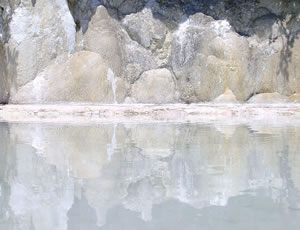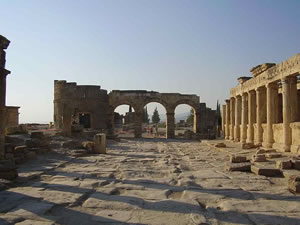The hot springs of Pamukkale can be found trickling down the white cliffs of Pamukkale in southern Turkey.
The cliffs cascade downward in a widening series of steps from a plateau more than 100m (300ft) high on Cal Da?i mountain.
Water constantly bubbles up from thermal springs under the plateau and emerges into the air at around 38°C (98.5°F). As it journeys underground to the surface, this warm water passes through beds of limestone, dissolving calcium carbonate from the rock.
 As the water flows over the edge of Pamukkale's escarpment, it cools and loses its ability to hold the mineral in solution. Consequently, the calcium carbonate, known in its solid form as travertine, gradually and continually precipitates out of solution as it descends the cliff face.
As the water flows over the edge of Pamukkale's escarpment, it cools and loses its ability to hold the mineral in solution. Consequently, the calcium carbonate, known in its solid form as travertine, gradually and continually precipitates out of solution as it descends the cliff face.
The graded steps on the cliff face are formed by Pamukkale's many scallop-shaped, water-filled pools. Because the outer margins of a pool cool first, the travertine precipitates at a faster rate here than at the centre. As the pools continue to deposit travertine, they grow slowly upward, and after many years create a series of "columns".
Water that steadily spills over a pool's raised edges trickles down the outside of the "column", depositing more travertine as a growing outer skin.
By constantly adding fresh layers of travertine to the cliffs, the mineral-rich water prevents plants from gaining a foothold and the elements from weathering Pamukkale into a dull, shapeless mass.
The name Pamukkale is Turkish for "cotton castle".
The Ancient City of Hierapolis
 The hot springs at Pamukkale have been used as a health spa for more than 2,000 years.
The hot springs at Pamukkale have been used as a health spa for more than 2,000 years.
The attractiveness of the Pamukkale springs led to the founding of the city of Hierapolis in 190 BC by King Eumenes II of Pergamon, a Greek kingdom that controlled much of Asia Minor.
The ancient city of Hierapolis was eventually destroyed by an earthquake in AD 17. Over the next two centuries, the Romans rebuilt it in their own style: with baths, a Temple of Apollo, a colonnaded street and a large amphitheatre that could seat an audience of 15,000 people.
Hierapolis became a popular resort for wealthy Romans, and at least three Roman Emperors are known to have visited the city.
Beside the ruins of the Temple of Apollo stands the Plutonium, a paved chamber about 3m (10ft) square dedicated to Pluto, the Roman god of the underworld. A hot stream entering the chamber through a fissure in the rock emanates vapors so noxious that the Plutonium has been dubbed in modern times the Place of Evil Spirits.
Behind the Roman theatre, and outside the defensive walls, which extend in a rough semicircle around the city, stands the 5th-century Martyrium of St Philip the Apostle. This octagonal church commemorates the death of St Philip who, after retiring to Hierapolis with his daughter, was martyred here in AD 80.
The building that houses the Roman Baths was constructed in the 2nd century AD. It remains remarkably well preserved, largely because the clergy and local inhabitants continually renovated the walls and the roof after it had been converted into a church during the 5th century.
The ruins of Hierapolis have become a modern tourist centre.